2015 Peugeot 208 run flat
[x] Cancel search: run flatPage 5 of 341
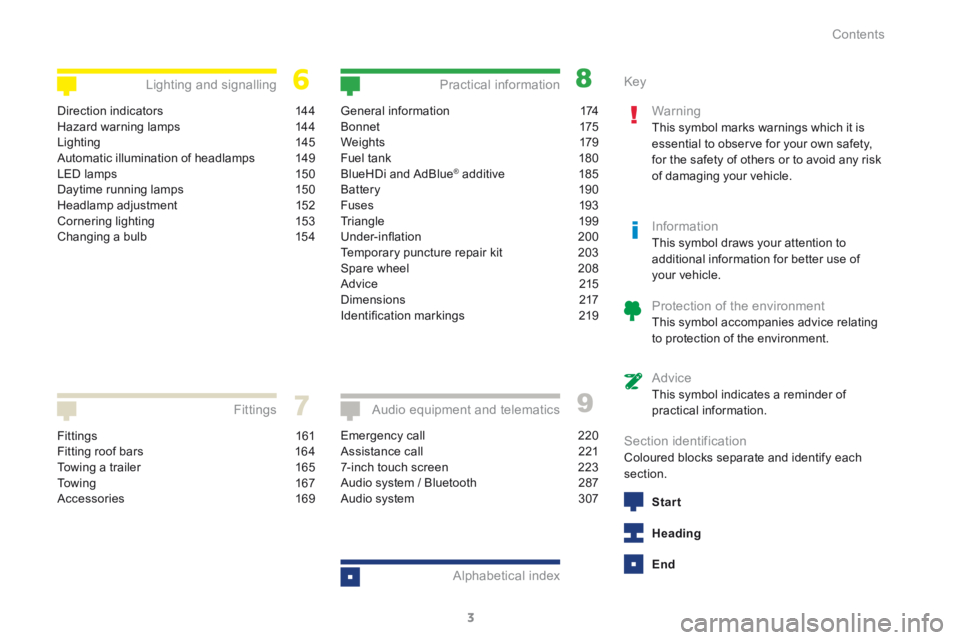
3
208_en_Chap00a_sommaire_ed01-2015
Fittings 161
Fitting roof bars 164
Towing a trailer 165
To w i n g 16 7
Accessories 169
Fittings
General information 174
B o n n et 175
We i g ht s 179
Fuel tank 180
BlueHDi and AdBlue
® additive 185
Battery 190
Fuses 193
Triangle 199
Under-inflation 200
Temporary puncture repair kit 203
Spare wheel 208
Advice 215
Dimensions 217
Identification markings 219
Practical information
Emergency call 220
Assistance call 221
7-inch touch screen 223
Audio system / Bluetooth 287
Audio system 307
Audio equipment and telematics
Alphabetical index
Direction indicators 144
Hazard warning lamps 144
Lighting 145
Automatic illumination of headlamps 149
LED lamps 150
Daytime running lamps 150
Headlamp adjustment 152
Cornering lighting 153
Changing a bulb 154
Lighting and signalling Key
Warning
This symbol marks warnings which it is
essential to observe for your own safety,
for the safety of others or to avoid any risk
of damaging your vehicle.
InformationThis symbol draws your attention to
additional information for better use of
your vehicle.
Protection of the environmentThis symbol accompanies advice relating
to protection of the environment.
AdviceThis symbol indicates a reminder of
practical information.
Section identificationColoured blocks separate and identify each
section.
Start
Heading
End
Contents
Page 6 of 341
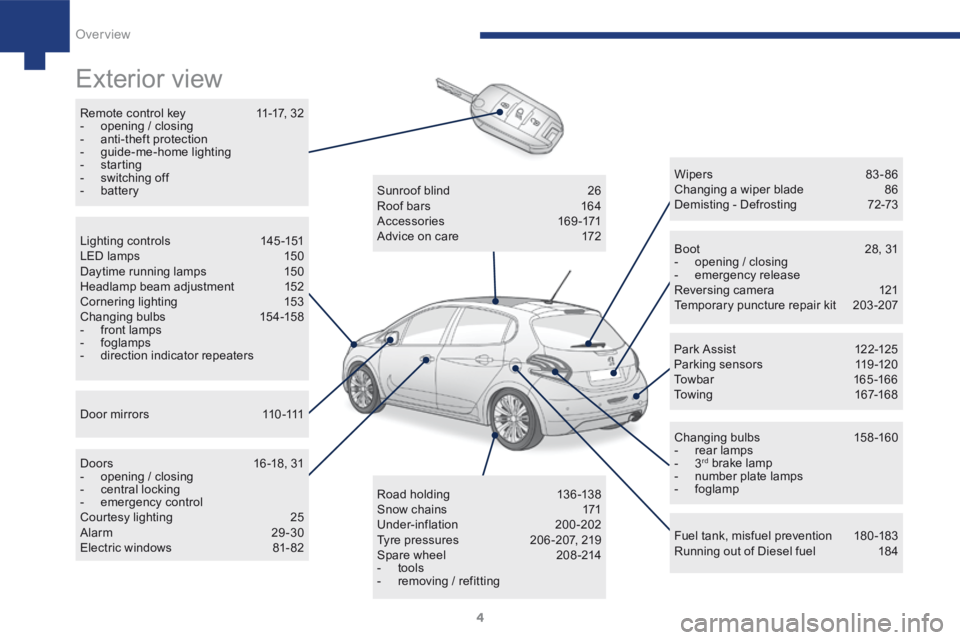
4
208_en_Chap01_vue-ensemble_ed01-2015
Exterior view
Remote control key 11-17, 32
- opening / closing
- anti-theft protection
- guide-me-home lighting
- starting
- switching off
- battery
Boot 28, 31
- opening / closing
- emergency release
Reversing camera 121
Temporary puncture repair kit 203-207
Wipers 83 - 86
Changing a wiper blade
86
Demisting - Defrosting 72-73
Changing bulbs 158-160
- rear lamps
- 3
rd brake lamp
- number plate lamps
- foglamp
Fuel tank, misfuel prevention 180-183
Running out of Diesel fuel 184
Sunroof blind
26
Roof bars 164
Accessories 169-171
Advice on care 172
Road holding 13 6 -13 8
Snow chains 171
Under-inflation 200-202
Tyre pressures 206 -207, 219
Spare wheel 208-214
- tools
- removing / refitting
Lighting controls
145-151
LED lamps 150
Daytime running lamps 150
Headlamp beam adjustment 152
Cornering lighting 153
Changing bulbs 154-158
- front lamps
- foglamps
- direction indicator repeaters
D o o r m i r r o r s 11 0 -111
Doors 16 -18, 31
- opening / closing
- central locking
- emergency control
Courtesy lighting 25
Alarm 29-30
Electric windows 81- 82 Par k A ssist
12 2-125
Parking sensors 119-120
Towbar 165 -166
Towing 167-168
Over view
Page 48 of 341
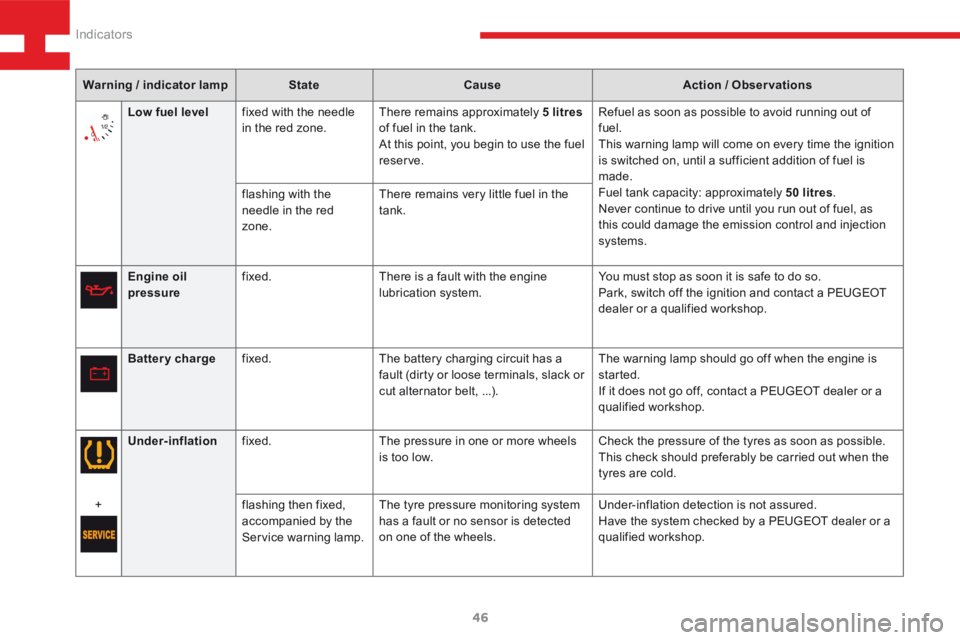
46
208_en_Chap03_Indicateurs_ed01-2015
Warning / indicator lampStateCause Action / Observations
Engine oil
pressure fixed.
There is a fault with the engine
lubrication system. You must stop as soon it is safe to do so.
Park, switch off the ignition and contact a PEUGEOT
dealer or a qualified workshop.
Battery charge fixed. The battery charging circuit has a
fault (dirty or loose terminals, slack or
cut alternator belt, ...). The warning lamp should go off when the engine is
started.
If it does not go off, contact a PEUGEOT dealer or a
qualified workshop.
Low fuel level
fixed with the needle
in the red zone. There remains approximately 5 litres
of fuel in the tank.
At this point, you begin to use the fuel
reserve. Refuel as soon as possible to avoid running out of
fuel.
This warning lamp will come on every time the ignition
is switched on, until a sufficient addition of fuel is
made.
Fuel tank capacity: approximately 50 litres
.
Never continue to drive until you run out of fuel, as
this could damage the emission control and injection
systems.
flashing with the
needle in the red
zone.
There remains very little fuel in the
tank.
Under-inflation fixed. The pressure in one or more wheels
is too low. Check the pressure of the tyres as soon as possible.
This check should preferably be carried out when the
tyres are cold.
+ flashing then fixed,
accompanied by the
Service warning lamp.The tyre pressure monitoring system
has a fault or no sensor is detected
on one of the wheels. Under-inflation detection is not assured.
Have the system checked by a PEUGEOT dealer or a
qualified workshop.
Indicators
Page 120 of 341
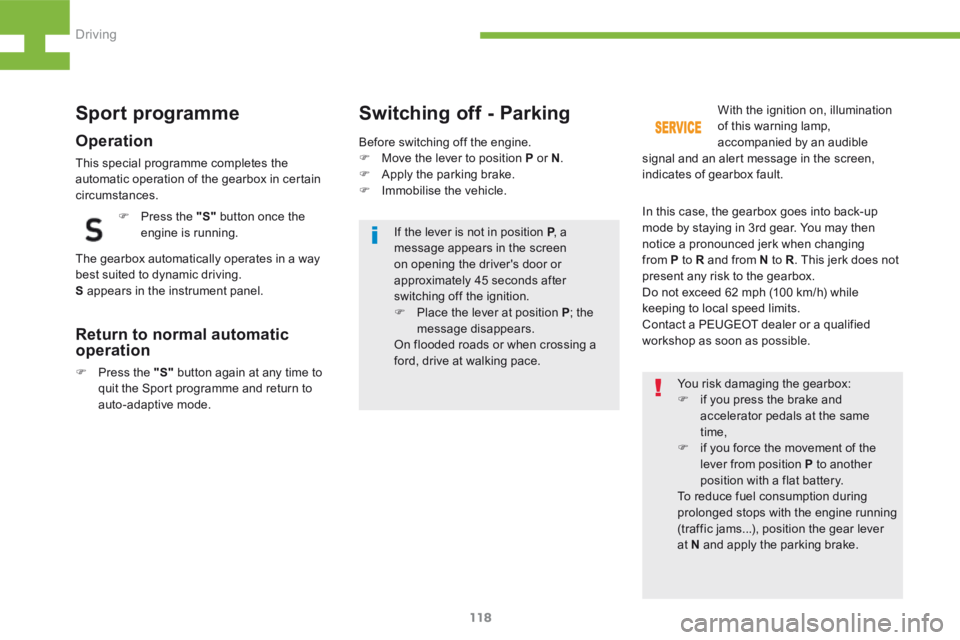
118
208_en_Chap05_conduite_ed01-2015
Sport programme
Operation
This special programme completes the
automatic operation of the gearbox in certain
circumstances.F Press the "S" button once the
engine is running.
The gearbox automatically operates in a way
best suited to dynamic driving.
S appears in the instrument panel.
Return to normal automatic
operation
F Press the "S" button again at any time to
quit the Sport programme and return to
auto-adaptive mode.
Switching off - Parking
Before switching off the engine.
F Move the lever to position P or N .
F Apply the parking brake.
F Immobilise the vehicle.
You risk damaging the gearbox:
F if you press the brake and
accelerator pedals at the same
time,
F if you force the movement of the
lever from position P to another
position with a flat battery.
To reduce fuel consumption during
prolonged stops with the engine running
(traffic jams...), position the gear lever
at N and apply the parking brake.
If the lever is not in position P
, a
message appears in the screen
on opening the driver's door or
approximately 45 seconds after
switching off the ignition.
F Place the lever at position P ; the
message disappears.
On flooded roads or when crossing a
ford, drive at walking pace. With the ignition on, illumination
of this warning lamp,
accompanied by an audible
signal and an alert message in the screen,
indicates of gearbox fault.
In this case, the gearbox goes into back-up
mode by staying in 3rd gear. You may then
notice a pronounced jerk when changing
from P to R and from N to R . This jerk does not
present any risk to the gearbox.
Do not exceed 62 mph (100 km/h) while
keeping to local speed limits.
Contact a PEUGEOT dealer or a qualified
workshop as soon as possible.
Driving
Page 173 of 341
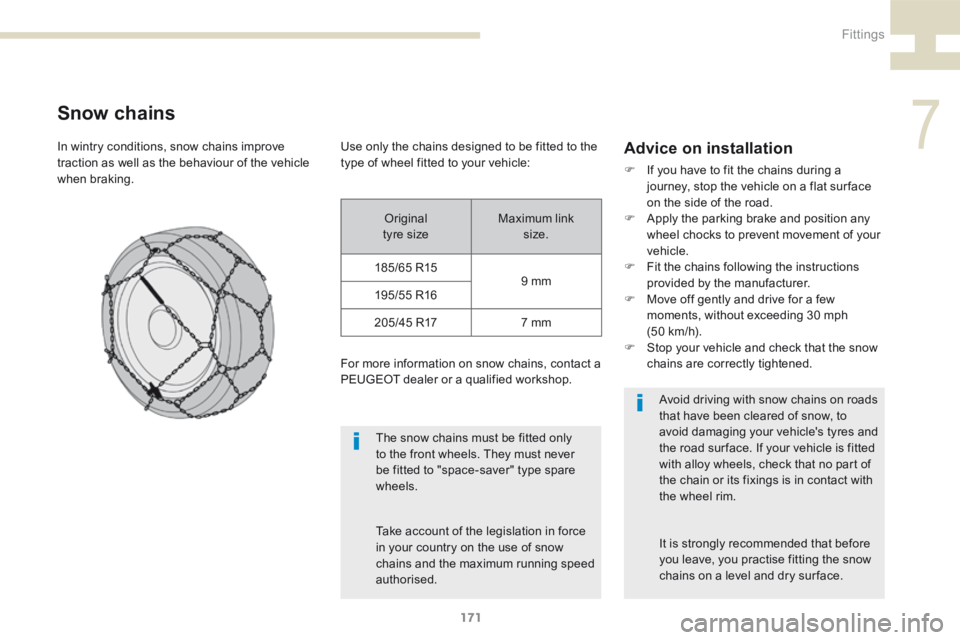
171
208_en_Chap07_ Amenagements_ed01-2015
Snow chains
The snow chains must be fitted only
to the front wheels. They must never
be fitted to "space-saver" type spare
wheels.
Take account of the legislation in force
in your country on the use of snow
chains and the maximum running speed
authorised.Avoid driving with snow chains on roads
that have been cleared of snow, to
avoid damaging your vehicle's tyres and
the road sur face. If your vehicle is fitted
with alloy wheels, check that no part of
the chain or its fixings is in contact with
the wheel rim.
Advice on installation
F
If you have to fit the chains during a
journey, stop the vehicle on a flat sur face
on the side of the road.
F Apply the parking brake and position any
wheel chocks to prevent movement of your
vehicle.
F Fit the chains following the instructions
provided by the manufacturer.
F Move off gently and drive for a few
moments, without exceeding 30 mph
(50 km/h).
F Stop your vehicle and check that the snow
chains are correctly tightened.
Use only the chains designed to be fitted to the
type of wheel fitted to your vehicle:
For more information on snow chains, contact a
PEUGEOT dealer or a qualified workshop.
Original
tyre size Maximum link
size.
185/65 R15 9 mm
195/55 R16
2 0 5 /4 5 R17 7 mm
It is strongly recommended that before
you leave, you practise fitting the snow
chains on a level and dry sur face.
In wintry conditions, snow chains improve
traction as well as the behaviour of the vehicle
when braking.
7
Fittings
Page 193 of 341
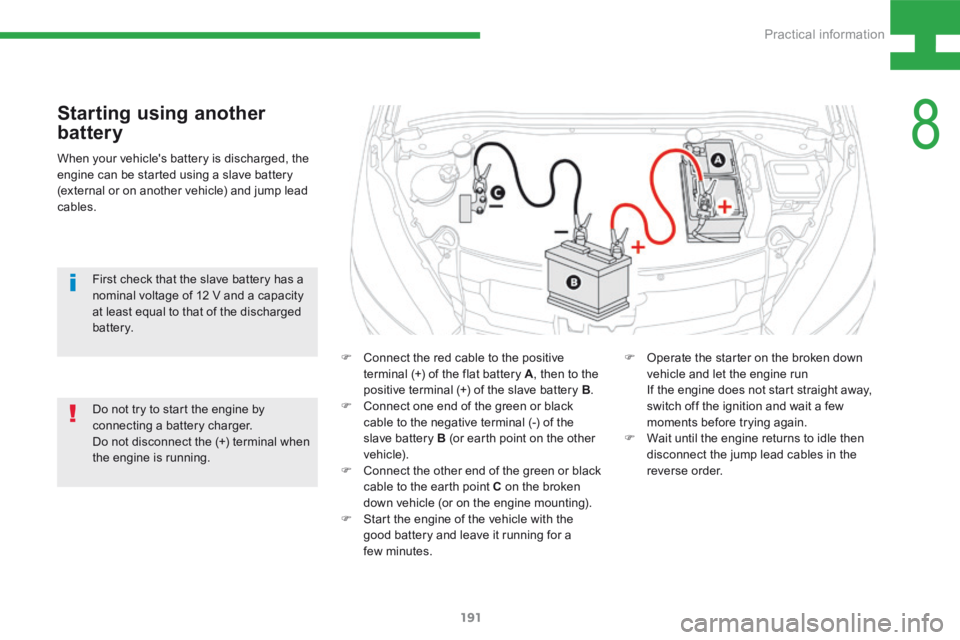
191
208_en_Chap08_Informations-pratiques_ed01-2015
Starting using another
battery
When your vehicle's battery is discharged, the
engine can be started using a slave battery
(external or on another vehicle) and jump lead
cables.F Connect the red cable to the positive
terminal (+) of the flat battery A , then to the
positive terminal (+) of the slave battery B .
F Connect one end of the green or black
cable to the negative terminal (-) of the
slave battery B (or earth point on the other
vehicle).
F Connect the other end of the green or black
cable to the earth point C on the broken
down vehicle (or on the engine mounting).
F Start the engine of the vehicle with the
good battery and leave it running for a
few minutes.
Do not try to start the engine by
connecting a battery charger.
Do not disconnect the (+) terminal when
the engine is running. First check that the slave battery has a
nominal voltage of 12 V and a capacity
at least equal to that of the discharged
battery.
F Operate the starter on the broken down
vehicle and let the engine run
If the engine does not start straight away,
switch off the ignition and wait a few
moments before trying again.
F Wait until the engine returns to idle then
disconnect the jump lead cables in the
reverse order.
8
Practical information